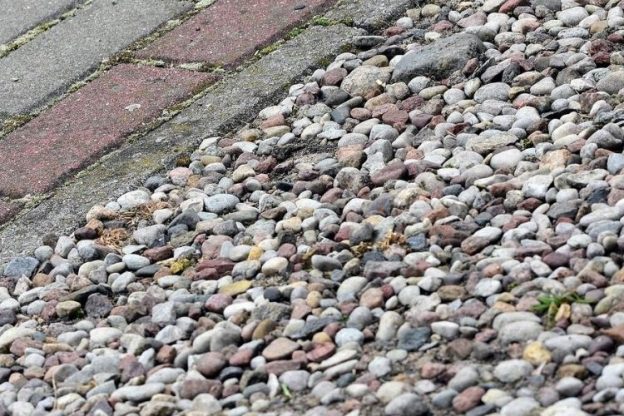In some cases, pebble or gravel paths are a good alternative to paved surfaces. Unlike the latter, they do not require large expenditures. They are not afraid of negative temperatures with soil swelling, to which hard coatings are so sensitive.
An additional argument in their favor is that technologically the construction of gravel paths is the initial stage of the construction of a paved surface. If the owner of the plot eventually has a desire to lay stone, paving slabs or clinker paving stones, he can always do this without losing the result of the work already done.
Gravel – Garden Path Installation
In harmony with the surrounding landscape
Gravel paths are a great element of landscaping. In many cases, they look even more advantageous than paved ones – primarily due to their natural “naturalness”.
A rich assortment of bulk material provides a good opportunity for the implementation of the most sophisticated and original solutions for the garden landscape. Having picked up a fraction of a suitable size and color, you can create a style dominant in the garden that best reflects the inner world of the owners.
Garden paths made of rounded smooth pebbles (pebble to pebble) look great surrounded by greenery or in the vicinity of water. A gravel surface framing a pond or fountain looks much more natural than a paving slab.
Material for bulk paths
Three types of materials are used for construction – pebbles, gravel crushed stone and crushed shale. Despite their some similarity, each of these materials has its own special properties, which determine their use.
Pebbles feature roundness and smoothness of shape. Those for whom the option – a pebble path with their own hands – seems attractive, should know that beautiful, design-winning pebbles have a functional drawback. The coating made of it does not take the load well, creeps under pressure. Therefore, walking on it is rather difficult. To reduce the creeping effect, the pebbles are poured in a small layer (no more than 5-7 cm) or mixed with crushed stone.
There are different types of pebbles: river, sea, lake, etc. River, for example, is less smoothed, more suitable for filling paths, while sea is better suited for design.
Rubble stones, thanks to the torn contour, adhere well to each other, so the summer cottage path made of gravel or rubble does not creep. It is much easier to walk on it than on pebbles. In terms of functionality, crushed stone is the best material for paths.
Crushed slate, which has a variety of color shades, is used primarily to create the desired decorative effect. With its help, you can give the surface the desired color.
Gravel path construction technology
To build gravel paths with your own hands, you do not need to have a builder’s qualifications and any special knowledge. The technology of their device is very simple, although there are still several points that require attention.
Trench marking and preparation
It is necessary to start work with marking – marking the contours of the track with a cord stretched on the pegs. Then you need to select the soil to a depth of 20-25 cm.
Important. One of the drawbacks of gravel paths is the germination of weeds. How to make a foundation to minimize the risk of their occurrence? The bottom of the trench must be dug to the depth of the shovel bayonet, and the dug out roots of the weeds must be removed. Then tamp the surface and cover the trench with geotextile. It will not only prevent weeds from germinating, but also hold the base together, making it stable. In addition to all this, for reliability, you can treat the land with herbicides, but it is advisable to do this before digging.
Installation of curbs
Sometimes this operation is made final, but technologically it is more convenient to perform it before backfilling. The function of the curbs is to give the path a complete look and prevent the gravel from spreading to the sides. The easiest way is to use standard curb stones, but another material is also suitable – brick, natural stone of a suitable shape (which will also serve as a decorative function), wooden chocks, installed vertically. In order for the curb to stand firmly and securely, it must be installed on a cement base.
Filling the trench
First, its bottom is filled with a layer (10 … 15 cm) of coarse gravel mixed with clay. The latter serves as a binder and base stabilizer. Sometimes clay is not used, being content with a mixture of gravel and sand. In this case, the path is obtained even with better drainage. But in any case, after laying the material, you must remember to properly tamp the bed.
Now you can start laying the surface layer. Often one crushed stone is used for this, but it is recommended to mix it with pebbles and crushed shale. In this case, each element of the mixture fulfills its role. Crushed stone provides surface stability and ease of walking, pebbles with their beautiful rounded shapes add an aesthetic element, slate does the same by coloring a dull gray surface with bright sparks of its inclusions.
In conclusion, it remains to level the surface with a rake.
Conclusion
Are there any “contraindications” for gravel paths? There are no absolute ones, but there are some circumstances in which caring for them can be difficult. For example, moles living on the site are capable of causing great damage to their appearance, “decorating” a flat surface with mounds. Therefore, before the construction of a gravel path in the country, it would be good to get rid of cute insectivores, preferably in a non-lethal way.
It is not recommended to arrange fill paths under dense trees. Removing large amounts of leaf litter from gravel can be a cumbersome job.
